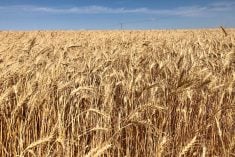CNS Canada — The difference between futures markets and cash markets for any exchange-traded commodities can usually be brought into focus by the basis — that is, except in Prairie wheat, where that focus has now gone fuzzy.
Typically, a wide or narrow basis provides some indication of how representative the futures market is of what’s actually happening in the physical market.
However, those signals appear somewhat muddied when it comes to wheat in Western Canada, as U.S.-dollar-based futures now are worked back to a Canadian elevator price using some confusing mathematics.
Read Also

U.S. grains: Soy futures set 15-month high after China agrees to purchases
U.S. soybean futures reached a 15-month high on Thursday after President Donald Trump’s administration said top-importer China agreed to buy tens of millions of tons of American crops in the next few years as part of a trade truce.
Basis represents the difference between the futures price and the price paid to the farmer, with transportation costs, storage fees, margins, et cetera factored into this number.
A wide basis may imply that the end-user doesn’t really want to buy right now or that the futures may be unnaturally high due to speculative interest. On the other side, a basis above the futures could provide a signal that the end user is willing to pay up in order to secure more coverage.
In a commodity such as canola, which has a futures market priced in Canadian dollars, basis levels can provide a fairly good picture of how badly the buyer wants, or doesn’t want, that commodity at a given time.
For wheat, the Canadian grain companies all calculate their prices off of the U.S. futures market — and right now in southern Manitoba, many elevators are offering nearby delivery opportunities with basis levels “above” the U.S. futures.
As an example, Cargill’s elevator at Morris, Man. was quoting basis for nearby delivery of No. 2 Canada Western Red Spring (CWRS) wheat, with 13.0 per cent protein, at 22 cents per bushel above the Minneapolis March futures on Friday (Jan. 30).
Cargill’s pricing webpage shows the price to the farmer for February delivery at C$5.79/bu. — technically, 22 cents above the closing Minneapolis futures price of US$5.57/bu.
However, that 22-cent difference fails to account for the fact that the Canadian dollar and the U.S. dollar are not one and the same.
With the Canadian dollar worth roughly US79 cents on Friday, if one wants to compare apples to apples, the Minneapolis March futures contract was worth C$7.05/bu. Using Canadian dollars across the board, the actual basis in this example comes in at C$1.26 below the futures.
Looking at it the other way, if both the futures and the cash price are calculated in U.S. dollars, the basis signal comes in at about US$1 per bushel below the futures.
“Internal information”
Cargill is only one of many, with most of the major grain buyers across the Prairies utilizing similar pricing signals.
“It’s a fairly complex formula, which could be considered internal information,” said one line company grain broker when asked for some clarification on the wheat basis calculation that seemingly ignores the exchange rates.
“There are about 20 steps between the port basis and the basis seen in the country,” he added, noting the cash price is worked backward from the price received in the export market.
While the failure of the grain companies to compare apples to apples from a currency standpoint appears to add an unnecessary complication to the wheat pricing environment, the line company official said this method was actually used in an attempt to simplify things for the farmer.
As a result, the wheat basis quoted by the grain companies may be seen as the basis “if” the futures were in Canadian dollars.
The easiest way to look at it may be to see the U.S.-dollar-denominated futures price quoted by the grain companies and resulting basis level as more of a reference number, than as actual prices. Whether that clears or muddies the issue may also be debatable.
— Phil Franz-Warkentin writes for Commodity News Service Canada, a Winnipeg company specializing in grain and commodity market reporting.













